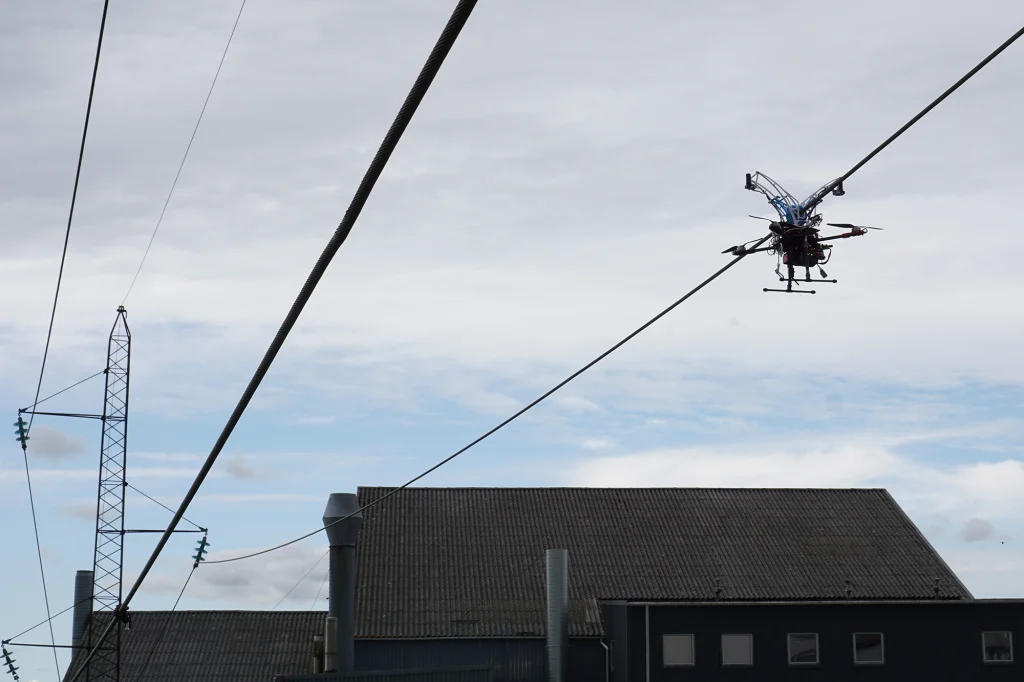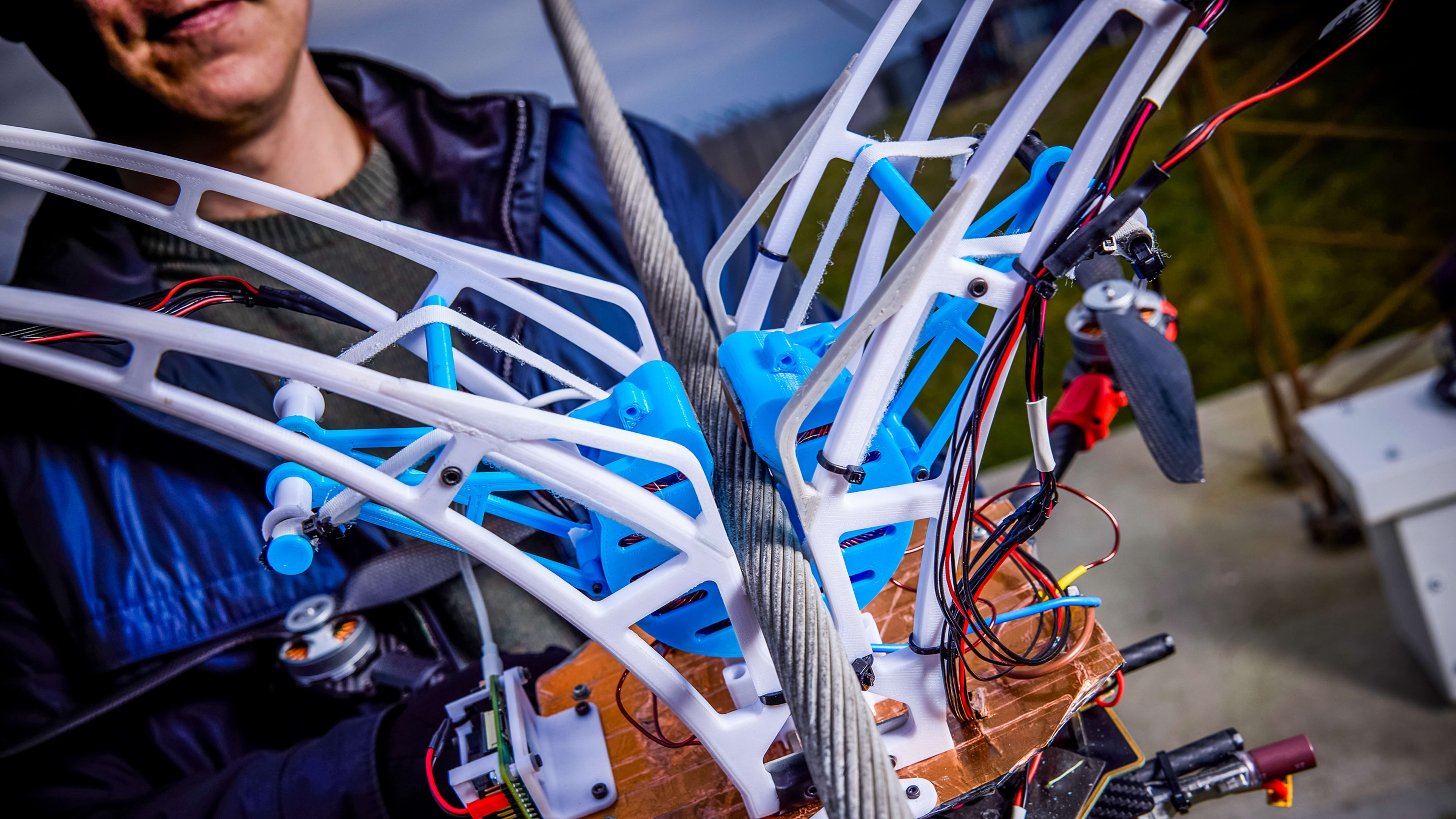Engineers from the University of Southern Denmark have developed an ingenious technology that enables a drone to fly practically forever, without ever having to return to the ground. Thanks to a docking mechanism, its sensors, and artificial intelligence system, the drone can recognize a power line every time it needs to recharge its batteries, approaching the high-voltage cable, and clinging to it from below, sucking electricity like some kind of electric vampire.
“The drones would be able to essentially live on the grid and operate completely autonomously for extended periods of time with no need for human interaction,” the development team explained over email.
The concept of using power lines to charge drones originated in 2017, when Emad Ebeid—a professor at University of Southern Denmark (SDU)—was exploring drone applications and found power line inspection to be an area of interest. According to the drone developers, Ebeid noted that the current inspection process, which relied on helicopters and ground personnel, was both costly and inefficient. He thought of drones as the natural alternative to this very expensive maintenance effort. These flying machines can be remotely controlled or even fly autonomously to watch over the lines.
There was only one problem: Drones have very limited battery life—a maximum of 40 minutes, with most industrial-level models dropping off at around 30 minutes of run time. Ebeid’s plan would require a human crew to be permanently near the drone, defeating the purpose of using these small autonomous machines.
To achieve complete autonomy, the drones needed to easily charge without human intervention. The obvious answer turned out to be right in front of Ebeid: the power lines themselves.
How they made it happen
Ensuring a drone could find, securely grab onto, and suck electricity from a power line would prove to be a challenging design problem to solve. The first issue the researchers tackled was how to get the drones to interact with the power line. “By default, drones are not meant to physically interact with anything other than the air during flight and the ground during landing,” the researchers explain. “So when we tested some of the early maneuvers to contact the power line with the drone, it would sometimes act in unexpected ways.”
During tests, a skilled safety pilot stood by who could take control of the drone. Any mistake could result in major damage and even wildfires if the drone went down in flames over a forest. After much testing, the scientists programmed the drone to approach the power line from below, decreasing the risk of collision.
From there, they had to figure out how to safely secure the drone to the power line. The researchers outfitted the drone with grippers, basically an insulated clamp that grabs the power line without conducting electricity to the drone itself. The grabbing mechanism doesn’t require motors to work. The drone’s software recognizes when the gripper is in the right place and activates an electromagnetic mechanism that snaps together, securely attaching the system.
This motorless design is important because the designers didn’t want to add more weight or additional points of failure to the system. The simpler, the better. When the drone batteries are full, a circuit cuts the current, the magnet stops working, and the grip opens freeing up the drone to fly again.
How to turn a drone into a vampire
The final design challenge was how to use the power line’s electricity to charge the drone without frying it into a fiery ball of metal and plastic. The drones couldn’t simply saddle up to a power line and steal its electricity. Typical power transmission lines carry anywhere form 1,000 volts to 800,000 volts. Consumer electronics, including drones, need dedicated transformers to convert electricity into something their batteries can manage (about 9 volts).
Carrying a transformer wasn’t an option—high-voltage transformers can weigh hundreds of tonnes. Instead, they decided to use inductive coupling. All high-voltage power lines leak energy in the form of a magnetic field around the cable. “The charging is done inductively and thus only relies on the current, not the voltage, of the power line,” the team explains. This induces a current in the drone’s energy harvester, a metal coil that works very much like your phone’s wireless charger. The current is then used to charge the drone’s battery. Depending on the cable’s voltage, a 9.4-pound drone will need to spend anywhere from 30 minutes to six hours on a power line.

The drone in action
Finally, after seven years of development, they got it all working. When the drone detects that its 7,000-mAh battery is close to its lowest level, it goes into “search and capture” mode. Its camera activates and identifies the nearest power line, maneuvering under the cable and slowly ascending. A cable guide engages and begins to move to make contact.
When the guide contacts the cable, it directs the drone upward in such a way that the open gripper aligns perfectly with the power-line cable. As it ascends, the gripper closes with the two sides of the clamp closing over the high-tension cable. After connection to the power line, the magnetic control circuit is activated to close the clamp safely. It is at this point that our “electric vampire” begins to suck energy using the inductive charger they invented.
The team conducted tests of the system at HCA Airport in Denmark, demonstrating that their system works and is efficient. The drone performed five recharging sessions without any human intervention, which allowed it to fly for two uninterrupted hours—a big jump from the typical 30 minutes. In theory, the drone would be able to fly indefinitely.
The next step, according to the engineering team, will be the optimization of the system and its durability to test it in adverse weather conditions. “It will be challenging to weatherproof the system and also make it resistant to very-high voltages,” the team says. For a drone to truly live on the grid, it must be extremely durable and reliable as it cannot pose a risk to public safety. “Measures must also be taken to avoid jamming and hijacking. So the next steps will involve lots of engineering work and testing to verify the functionality and safety of the system,” the researchers explain.
A huge opportunity
Before we see vampire drones flying in the sky, other matters must be solved, such as who is going to be paying for the power that is being sucked from the lines. The drone is technically “stealing” power that would otherwise not have been lost. “A utility company might technically be able to see the drone as a tiny additional load on their network,” the inventors describe. The researchers believe that eventually utility companies will use this kind of drone to cut down the huge costs of power-line monitoring and maintenance.
Though the drone will remain a research and enterprise project, it’s not hard to see how, in the future, the average drone enthusiast or any industry could equip their drone with it. Coupled with a power-metering solution, anyone would be able to calculate the consumption of power from the grid.
Once all the loose ends are solved, the opportunity for our civilization is huge. “There are approximately 25 million miles of power lines worldwide, enough to circle planet Earth 1,000 times, most of which are AC,” the team says. And all these can be used by any type of drone to recharge, providing all kinds of 24/7 networks that can change the way entire industries monitor, regulate, and optimize their operations.
That will mean saved money and—in many cases, such as emergency operations—saved lives. As the inventors say, the applications and benefits that may be derived from this tech are “as vast as the global power-line network itself.”
Recognize your brand’s excellence by applying to this year’s Brands That Matter Awards before the final deadline, June 7.
Sign up for Brands That Matter notifications here.
